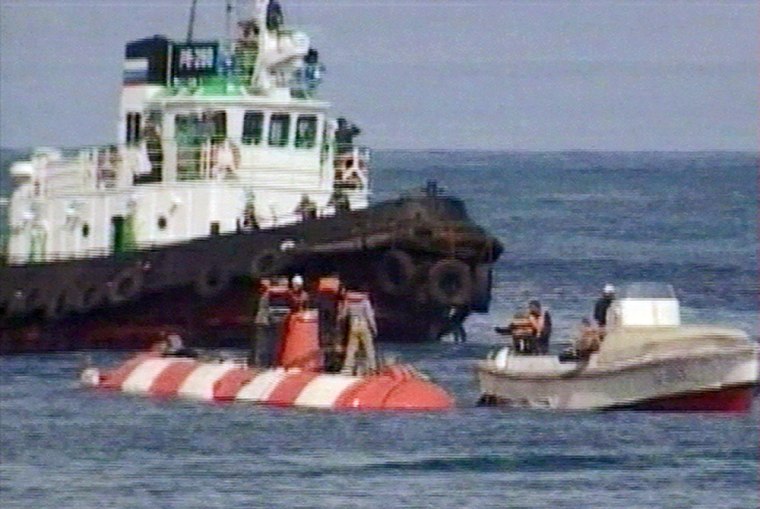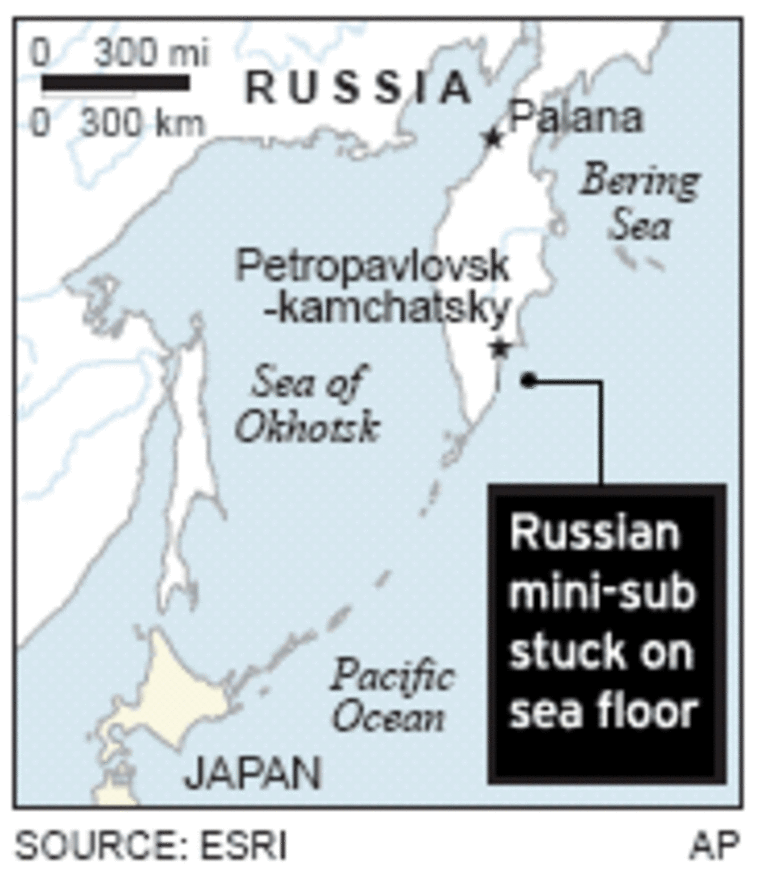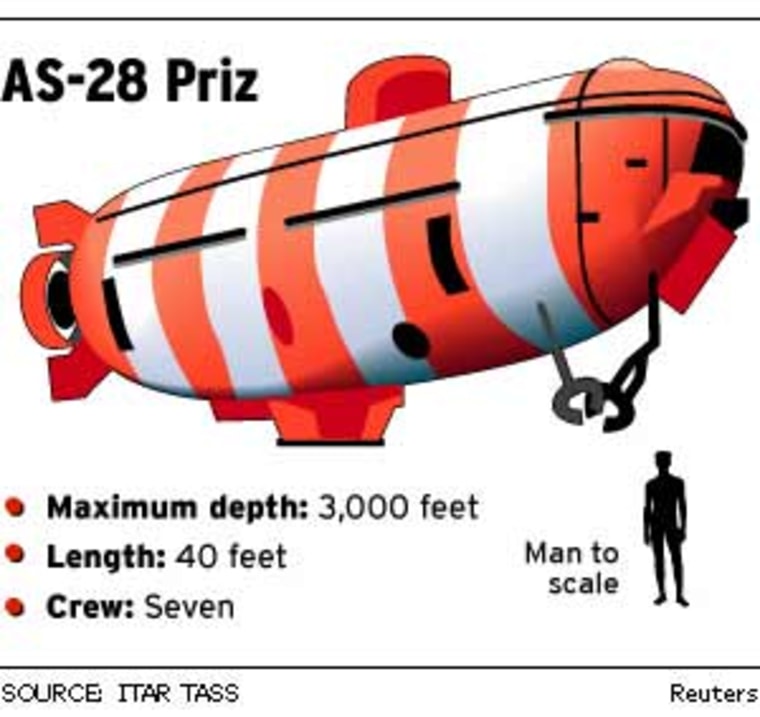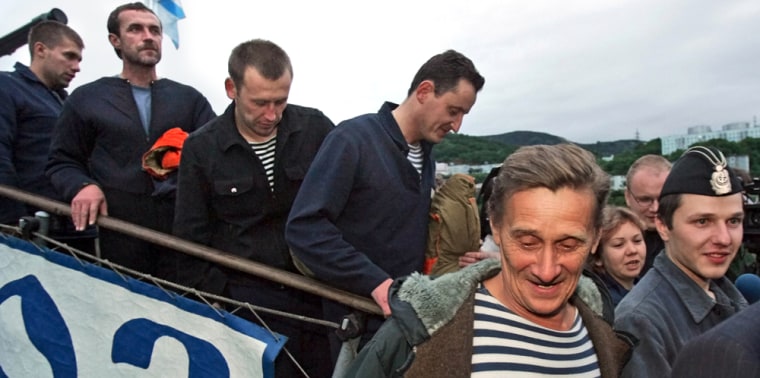The seven men endured darkness and frigid temperatures for three days until their Russian mini-submarine was freed Sunday from the Pacific floor by a British remote-controlled vehicle as oxygen supplies dwindled.
“It was cold, cold, very cold. I can’t even describe it,” one crew member with reddish hair said as the sailors walked ashore with dazed looks and bloodshot eyes after their vessel was cut loose from cables that had snagged it.
The men aboard the AS-28 mini-submarine — six sailors and a representative of the company that made the ship — had opened the hatch and climbed out without assistance, officials said.
Six were taken to a hospital on the mainland for examination, waving to relatives as they went in. The seventh was kept aboard a hospital ship for unspecified reasons. They appeared to be in “satisfactory” condition, naval spokesman Capt. Igor Dygalo said.
At the edge of the gangplank leading off the ship that brought the crew to shore, the submarine’s commander Lt. Vyacheslav Milashevsky held a long and solemn salute, then a slight smile crossed his face.
He was pale but told journalists he felt “fine” before climbing into a van with the others for the trip to the hospital. Another crew member in the van looked from side to side, gazing at the green trees and gray skies.

Milashevsky’s wife, Yelena, said earlier that she was overjoyed upon hearing about the rescue. “I was happy. I cried from happiness. I danced,” she told Channel One television.
The men had worn thermal suits to protect them against temperatures of about 40 degrees and were told to lie flat and breathe as lightly as possible during the rescue effort, officials said. To conserve electricity, lights were turned off and contact with the surface was kept to a minimum.
The crew member with reddish hair said he felt OK and was eager to be reunited with his wife and daughter. He was then ushered in the van taking the men to the hospital and did not reply when asked his name.
Russian authorities thanked the British and praised the international effort that included the United States, but criticism quickly arose over why the nation’s once-formidable navy needed outside help.
Memories of Kursk
The relief over the successful rescue attempt was in sharp contrast to the sinking of the Kursk nuclear submarine in August 2000, when Russian authorities held off asking for outside assistance until hope was nearly exhausted; all 118 crew died.
President Vladimir Putin was criticized then for reluctance to seek international help and for remaining on vacation as the disaster unfolded. The president has been silent through the present crisis as well, although his spokesman Alexei Gromov said Putin was grateful to all those involved in the rescue operation.

Defense Minister Sergei Ivanov, who supervised the rescue operation from a navy ship, clenched his fists and shook them in happiness when he saw the red-and-white-striped sub surfacing.
“We have seen in deeds, not in words, what the brotherhood of the sea means,” he said.
The Foreign Ministry also issued a statement praising the joint actions of the Russian, British and U.S. militaries in the “unique rescue operation.” It also thanked Japan, which it said also responded to the request for help.
The United States sent remote-controlled underwater vehicles for the rescue. They arrived several hours later and were not used, but three American divers and a doctor accompanied the British vessel on its mission.
The jubilation came after three tense days that started Thursday when the 44-foot submarine stranded in 600 feet of water off the Kamchatka coast.
Russian ships first tried to tow the sub to shallower water where divers could reach it but were able to move it only about 60-100 yards in the Beryozovaya Bay.
Six hours of cutting
The British remote-controlled Super Scorpio, sent in response to Russia’s urgent call for help, arrived Saturday and spent six hours the next day cutting away the fishing net cables that had snarled the Russian vessel and its propellor.

British Royal Navy Commander Ian Riches said the most nerve-racking point in the operation was when the Russian submarine broke free from the cables and disappeared from the camera’s sight before surfacing about 4:26 p.m.
“It was a difficult operation, but we enjoyed doing it,” he told The Associated Press. “The team are over the moon that we have got these guys out alive.”
The circumstances surrounding the cause of the accident remained unclear.
Putin ordered the defense minister to launch an investigation. Dygalo declined comment when asked about how the sub was trapped, saying only that it had been “engaged in planned maneuvers.”
Some naval officials had said the submarine was participating in a combat training exercise when it got caught on an underwater antenna assembly that is part of a coastal monitoring system.
But Riches, the British commander, said the vessel had become tangled in fishing nets, as had been originally reported.
“The submarine was caught very firm into the fishing nets and had driven into them so that they were very tight and they actually looked and behaved like steel wires, so it was very, very difficult to cut through with cutting implements,” Riches told The Associated Press.
Russia’s cash-strapped navy apparently lacks rescue vehicles capable of operating at the depth where the sub was stranded.
The new crisis indicated that Putin’s promises to improve the navy’s equipment have had little effect. He was sharply criticized for his slow response to the Kursk crisis and reluctance to accept foreign assistance.
New criticism arose within hours of Sunday’s rescue. Dmitry Rogozin, head of the nationalist Rodina party in the lower house of parliament, said he would demand an assessment from the Military Prosecutor’s Office of the navy’s performance in the incident, the Interfax news agency reported.
Rogozin said he wants to know why Russia has not acquired underwater vehicles similar to the ones provided by Britain and the United States and “why fishing nets and cables litter the area of naval maneuvers.”
